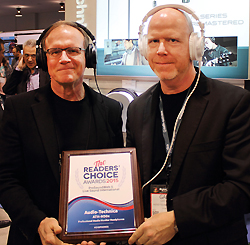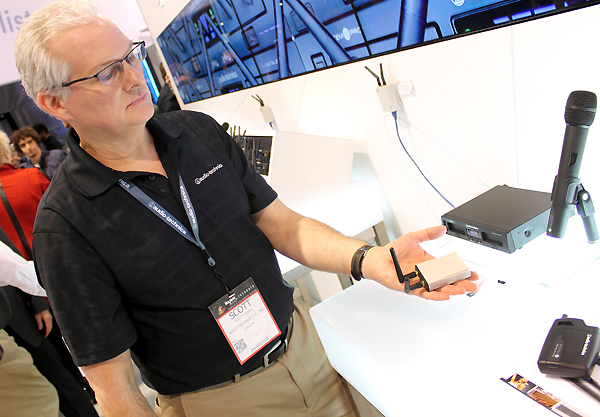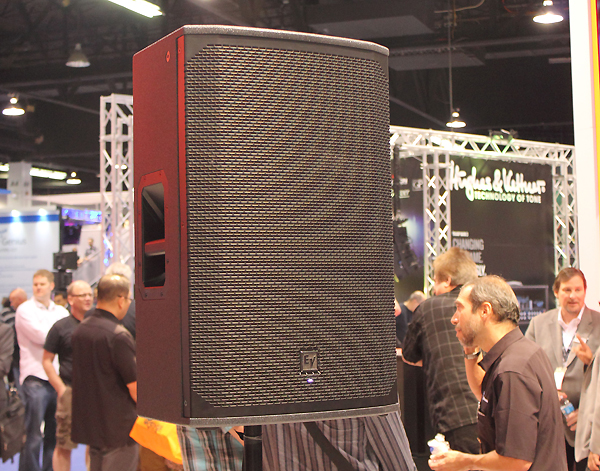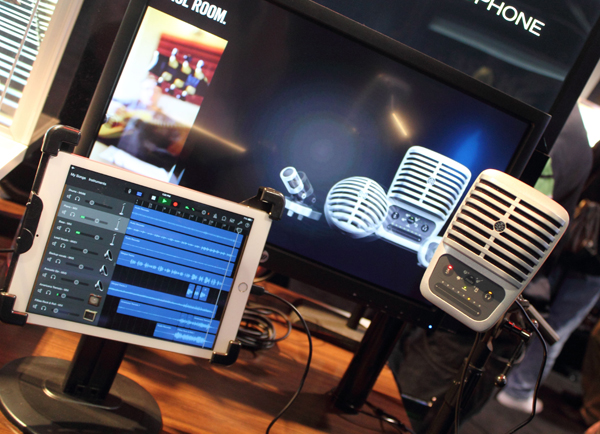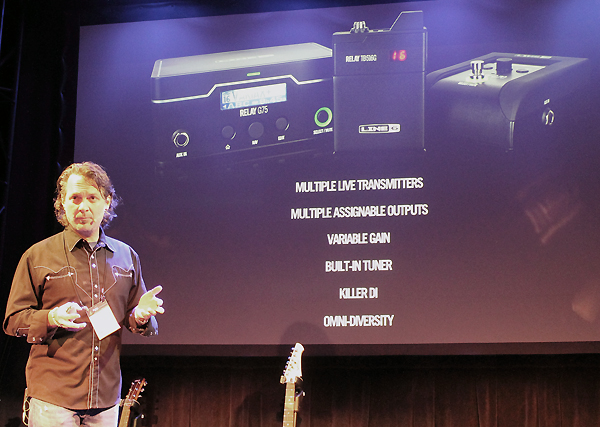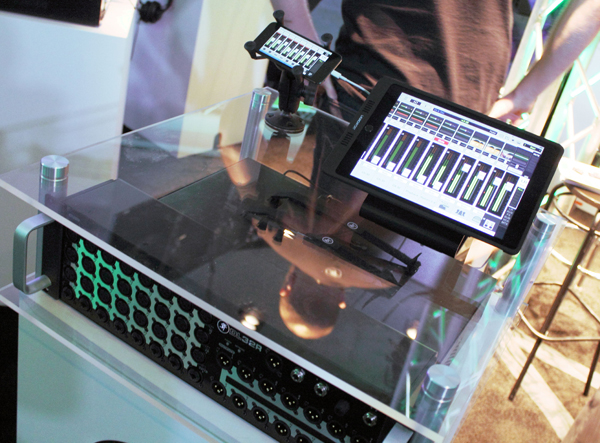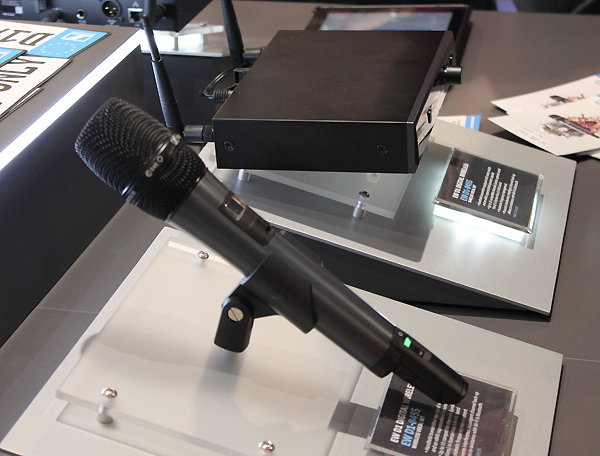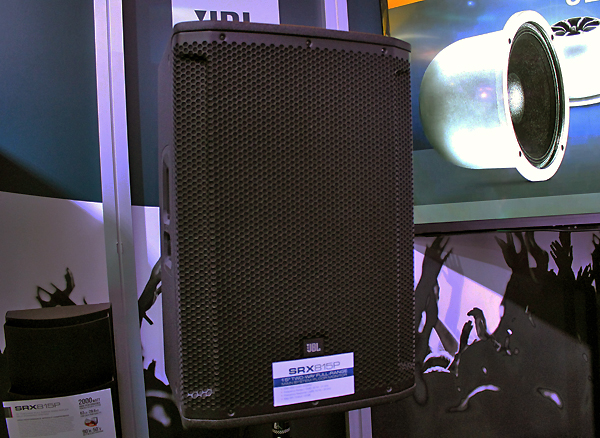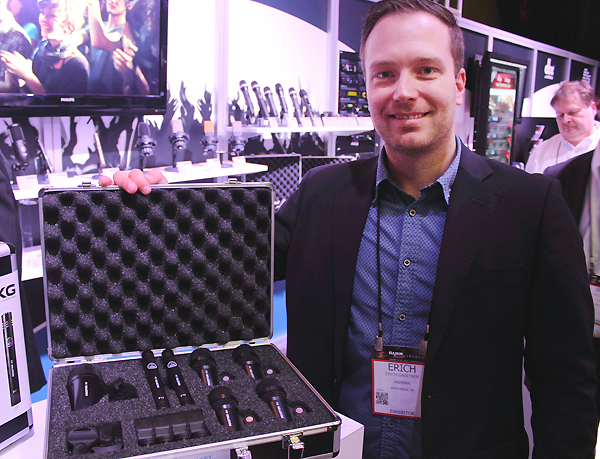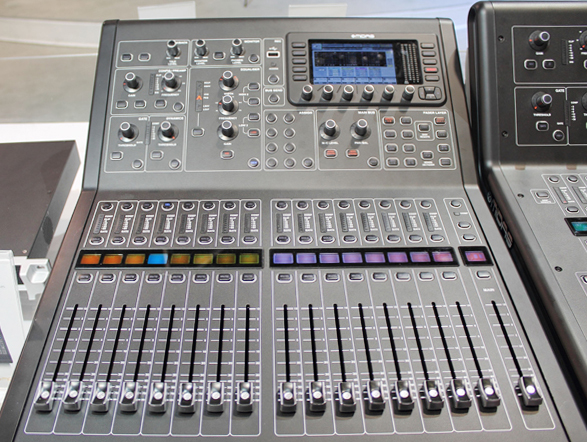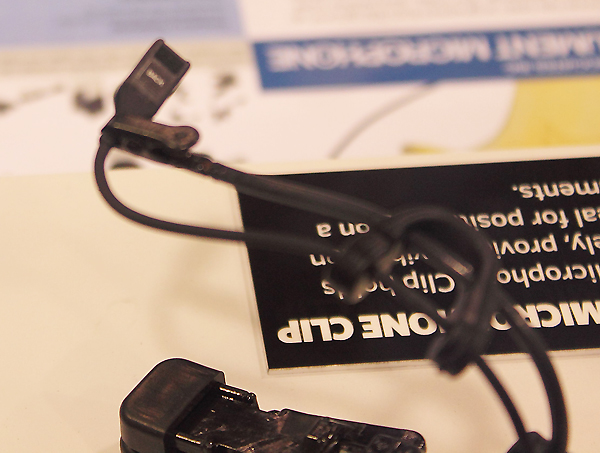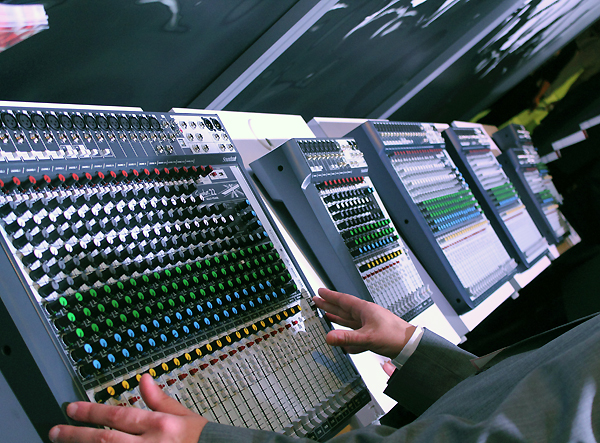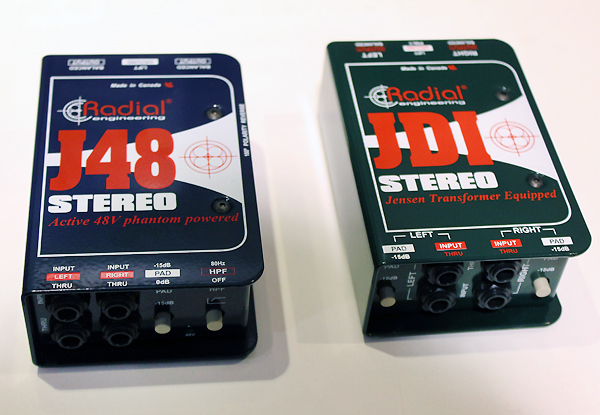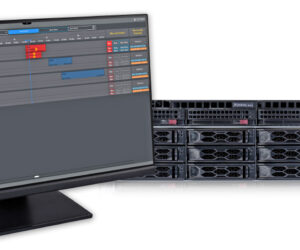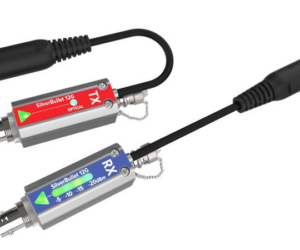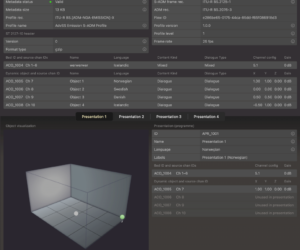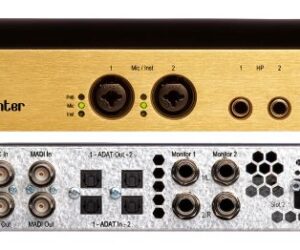The NAMM convention brings announcement after announcement of new products, from pro audio gear to percussion pieces—and the 2015 edition of the show last week in Anaheim proved no exception.
For the lucky few of us who were there, we got to see the new gear up close, and even put our hands on it. Wading through the sea of press releases, amazing new devices—and a few eyebrow raisers—I’ve culled a list of noteworthy products making their debut at this year’s show. (In a couple of cases, the products had been previously introduced, but this was their first show appearance.)
Here’s the first dozen, with another 12 or so to follow tomorrow. I’ve called out the facets that are the most interesting to me, but be sure to click on the link for each to get additional information.
Audio-Technica System 10 PRO Rack-Mount Digital Wireless System. The new System 10 PRO Rack-Mount (pictured here with Scott Shaw of A-T) solves the problem of limited wireless range. Mounting receivers on stage removes front of house monitoring, and traditional antenna extenders are expensive.
It allows for extending the range by pulling out an antenna cartridge from the receiver, mounting it elsewhere (up to 300 feet), and running a Cat-5 cable between them. Add in daisy-chaining up to 10 of the receiver units via RJ12 cable, and this was my favorite new release at NAMM.
Electro-Voice EKX Portable Loudspeakers. Available in both passive and powered loudspeaker configurations. Powered models have QuickSmart DSP processing, high-efficiency Class D power amplifiers, and intelligent heat management. Both types come in 12- and 15-inch 2-way versions and 15- or 18-inch subwoofers.
EV provided a 5-minute demonstration of multiple configurations, including 2-way only as well as full 2-way and subwoofer pairings. These loudspeakers provide solid mids and crisp highs, with a nice amount of low end, while the subs deliver deep lows with clarity and substance. It was hard to leave the demo.
Allen & Heath QU-PAC Digital Mixer. A slim-lined unit that provides the remote controls for complex mixing while providing a tactile interface, with touchscreen, appropriate for schools, hotels, and conference centers where simplicity is key.
The touchscreen interface is easy to use and understand. As an added bonus for multi-use venues, the QU-PAC includes permission setting to control what a user may or may not do. This enables the venue’s tech to set up the system but prevents anyone else from screwing it up. (And yes, that’s a technical phrase.)
Shure MOTIV Digital Microphones & iOS App. The MV88 is a stereo condenser mic capable of connecting to any iOS device with a Lightning plug. The MV5 is a USB microphone with three onboard DSP presets (vocals, flat, instrument).
The show-stealer is the rugged metal-cased MV51, which combines a large-diaphragm condenser mic with the new MVi touch-panel interface with quick access to gain, mute and headphone monitoring volume adjustments as well as five onboard presets. I could have dropped it with no fear of damage. The MV5 and MV51 can also connect to iOS devices and work with the ShurePlus MOTIV app for real-time adjustments and the sharing of files.
Line 6 Relay G70 & G75 Wireless Systems. Multi-instrumentalists give audio engineers a headache every time they swap instruments while using the same pedalboard. Line 6 has come to the rescue with the G70 and G75 wireless systems, which feature hands-free switching between up-to 16 different color-coded transmitters with locking cable connectors and either amp top or pedalboard-designed receivers.
Gain control is set at the transmitter so all instruments send the same signal level through to front of house. Tap the receiver’s button until the button ring color matches that of the transmitter. With a latency time of 1.48 ms and zero signal compression, bass players can hear the lows as if they were running straight through their amplifier. As one who has to ride the fader every time a musician switches instruments, I’d love to have a Relay system in my toolbox.
Mackie DL32R Wireless Digital Mixer. An impressive 32-channel remote mixing system that allows for offline setup, multi-track recording, individual personal monitor mixing, and virtual sound check all through the easiest interface. Just announced at the show is the new DL Dante expansion card that provides 32 x 32 channels of network audio I/O.
Another great feature is the metering view of all channels at once – the perfect way to see which channel might have a problem. According to the app designer, it’s the smoothest metering display on the market. Having examined several app-based mixers, the Mackie app is my favorite.
Sennheiser evolution wireless (ew) D1. The D1 could be considered the ultimate plug-and play wireless microphone system. Through automatic unit pairing and transmission frequency selection, any number of units could be set up in moments and the built-in frequency scanner keeps them on the clearest of frequencies.
Then come the more unusual features of the microphone: automatic gain control, 7-band graphic EQ, de-esser, and low-cut filter. It’s not a microphone I’d use in conjunction with a digital console where EQ work would better reside. However, the seven-band graphic EQ could be used to tailor the microphone to a person when gigging and using analog consoles.
JBL SRX 800 Series Powered Loudspeakers. Equipped with JBL transducers, Crown’s DriveCore Technology, user-configurable DSP, and full HiQnet Network control. The onboard DSP includes 96 kHz FIR (Finite Impulse Response) filters for crossover tuning and delay adjustment.
Available is the 12-inch 2-way SRX812P, 15-inch 2-way SRX812P, and dual 15-inch 3-way SRX835P, as well as the single-18-inch SRX818SP and dual-18-inch SRX828SP subs. Output ratings are stated as between 135 dB and 141 dB, depending on model. Expect the distinct bass feel common to JBL.
AKG Session I Drum Microphone Set. The starter Groove Pack drum microphone kit, containing six mics with three for toms and snare, has gained a microphone while keeping the same price.
The new Session I kit (picutred here with Erich Gaertner of AKG) adds another P4 dynamic cardioid mic to the mix. While a drum kit can technically be captured with only a couple of microphones, I’ve found seven a requirement for most live situations. Look to the Session I for a good, basic but complete drum mic kit.
Midas M32R Digital Console. The M32 has shrunk in terms of size but not in capability. The new M32R has 40 input channels controlled over one 16-fader surface. The upper console area, with channel controls and display screen, does a mixed job with the smaller area of real estate.
The controls are condensed into a smaller space but without any impact to usability. Where the M32R does fall a tad short is in the reduced size of the display screen. The saving grace is that like it’s big brother, it includes iPad, Android, Mac and PC remote mixing.
Countryman Isomax 2 (I2) Instrument Microphone. The flat-response, low-noise I2 is a low-profile microphone that can be added to a number of Countryman-designed instrument mic clips for optimal placement on brass and string instruments as well as pianos.
It also comes in the Isomax 2-H hanging mic with a non-twisting cable with bendable end for exact positioning – important when using a non-omni microphone. Both come in omnidirectional, cardioid, and hypercardioid polar patterns. Testing the I2, the deep nulls in the hypercardioid demonstrated rejection of stage noise so often a concern with live engineers.
Soundcraft Signature Series Analog Consoles. Actually more than a line of analog consoles. As analogs go, ranging from 10-input consoles to 22-input consoles, these have everything expected plus two sweeping mid-range EQs per channel and built-in Lexicon studio-grade effects.
Then comes the bonus. The 12- and 22-channel versions include USB multi-track recording, a regular feature of digital consoles. My only complaint is the top-mounted plugs on the larger 22-channel console, but it’s sacrifice to keep the price down, the Soundcraft rep told me. For a 20-plus channel multi-track recorder, I can live with it.
Radial Engineering JDI Stereo & J48 Stereo. The popular JDI passive and J48 active direct boxes offered in stereo, both available in February for about $299.
Additionally, Radial announced the new IceCube IC-1, a compact balanced line isolator for elimination of hum and buzz caused by ground loops in audio systems. It’s rated as providing a linear response from 20 Hz to 18 kHz. When ground loop problems can’t be eliminated, it’s good to know the IceCube, at only $69, can solve the problem.
Be sure to check back in tomorrow for Part 2!
Chris Huff writes about church audio at Behind The Mixer, covering everything from audio fundamentals to dealing with musicians.


